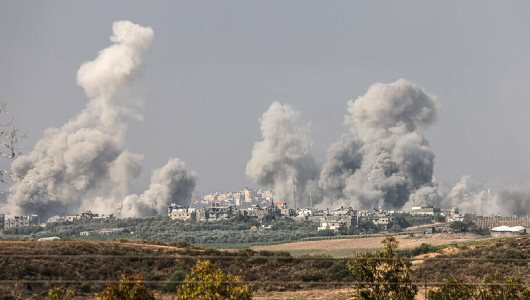Gaza’s health ministry reported on Monday that over 5,000 people have been martyred in the besieged Palestinian enclave since Israel initiated its intensive bombing campaign more than two weeks ago.
Concerns have grown about the escalating humanitarian crisis in Gaza as a result of the ongoing war, which was triggered by a Hamas attack on October 7. According to Israeli officials, this attack resulted in the death of more than 1,400 people who were killed by various means, including gunfire, stabbing, and burning, at the hands of the Palestinian group. Additionally, Hamas took more than 200 hostages.
On a day when the Israeli army reported over 300 new airstrikes within 24 hours, Gaza’s health ministry stated that the martyred toll had risen to over 5,000, with more than 2,000 of them being children. These figures have not been independently verified by AFP.
Thousands of buildings have been destroyed, and more than one million people have been displaced in the territory, which has been under siege and faced severe shortages of water, food, and other essential supplies.
A convoy of about a dozen trucks carrying urgently needed aid, the third in three days, arrived in Gaza from Egypt on Monday through the Rafah crossing, which is not controlled by Israel.
The United States, which has facilitated the entry of aid convoys, has committed to a continuous flow of relief goods into Gaza, while UN aid agencies have emphasized the need for much more assistance.
Fighting continued overnight, with Prime Minister Benjamin Netanyahu reiterating Israel’s determination to “erase Hamas,” as a full-scale ground invasion loomed.
Gaza’s Hamas-controlled government media office reported that “more than 60 were martyred in the raids” during the night, including 17 in a single strike that hit a house in Gaza’s north. At least 10 more people died in new strikes early Monday.
The Israeli military stated that it had targeted “over 320 military targets in the Gaza Strip” in the past 24 hours, including tunnels containing Hamas militants, operational command centers, military compounds, and observation posts used by the Islamic Jihad, another group.
Residents of Rafah described the impact of the ongoing conflict, with one individual mentioning a recent bombing that had caused damage to windows and doors but expressed relief at their safety.
Israeli forces are positioned near the Gaza border, and smaller units have conducted limited incursions targeting Hamas and seeking to rescue hostages, whose number Israel now estimates at 222.
Tensions have also risen in the occupied West Bank, where 95 Palestinians have been martyred in clashes involving Israeli security forces or settlers since the Gaza conflict began.
Israel has been evacuating southern communities near Gaza due to the ongoing hostilities.
The health ministry in Gaza has called upon citizens to donate blood to address the growing medical needs as thousands have been wounded.
The dire needs of the 2.4 million civilians trapped in the 40-kilometer (25-mile) long coastal strip, which was already blockaded and impoverished before the war, have raised concerns.
US President Joe Biden facilitated the passage of aid convoys in talks with Egyptian and Israeli leaders last week, but the United Nations has estimated that Gaza requires about 100 trucks of relief goods every day.
UN aid chief Martin Griffiths stressed the importance of additional humanitarian aid, stating that the recent delivery of food, water, and medical supplies provided “another small glimmer of hope” for the millions in need.
Israel’s refusal to allow fuel into Gaza has raised concerns about the functioning of ambulances, hospital incubators for infants, and water desalination plants in the near future.
(Islamabad51_Newsdesk)














